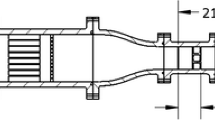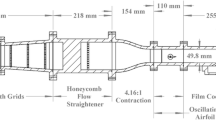Abstract
The laminar flowfield in a rectangular channel immediately upstream of a hot film gradient probe with two parallel films was investigated in the range of Reynolds number Re pr= 6 to 95, with the Reynolds number based on the probe diameter and the local flow velocity. For this study a photochromic dye flow visualization technique was used. The results show that the smaller the Reynolds number Re prthe larger the influence of the probe is upon the flowfield. No distinct influence of the probe location relative to the channel walls on the flow deceleration process immediately upstream of the probe was observed.
Similar content being viewed by others
Abbreviations
- a :
-
distance between the hot films
- d h :
-
hydraulic diameter
- d pr :
-
diameter of the probe body
- \(\operatorname{Re} = \frac{{\bar u \cdot d_h }}{v}\) :
-
Reynolds number based on hydraulic diameter and mean flow velocity
- \(\operatorname{Re} _{pr} = \frac{{\bar u \cdot d_{pr} }}{v}\) :
-
Reynolds number based on probe diameter and the undisturbed flow velocity at the centerline of probe
- u :
-
flow velocity in x-direction
- u 0 :
-
undisturbed velocity in the center of the channel
- ū:
-
undisturbed mean flow velocity
- u(x,y):
-
velocity at position (x,y)
- \(\frac{{du}}{{dy}}\) :
-
averaged velocity gradient
- x :
-
coordinate in main flow direction
- y :
-
coordinate normal to the larger wall of the rectangular channel
- z :
-
coordinate normal to x and y
- v :
-
kinematic viscosity
References
Bottcher, J. 1983: Investigation of the flowfield immediately upstream of a hot film probe using a photochromic dye visualization technique. M.Sc. Thesis, Department of Mechanical & Environmental Engineering, University of California, Santa Barbara
Bottcher, J. 1982: Die Messung des Geschwindigkeitsgradienten mit Heißfilmsonden. MPI für Strömungsforschung, Göttingen, Rep.107/1982
Humphrey, J. A. C. 1977: Effect of turbulence on the precision of velocity and velocity fluctuation data obtained by photochromic visualization. Can. J. of Chem. Eng. 55, 126–130
Humphrey, J. A. C. et al. 1974: Experimental study of the internal fluid dynamics of forming drops. Can. J. Chem. Eng. 52, 449–456
Hutchins, J.; Johnson, G.; Marschall, E. 1984: Flow visualization in two-phase flow. In: Measuring techniques in gas-liquid two-phase flow. (ed. Delhaye, J. M.; Cognet, G.) pp. 91–102, Berlin, Heidelberg, New York, Tokyo: Springer
Johnson, G. 1983: Investigation of velocity distribution during drop formation and release. Ph.D. Dissertation, Department of Mechanical and Environmental Engineering, University of California, Santa Barbara
Popovich, A.; Hummel, R. 1967: A new method for non-disturbing turbulent flow measurement very close to a wall. Chem. Eng. Sci. 22, 21–25
Smith, J.; Hummel, R. 1973: Studies of fluid flow by photography using a non-disturbing light-sensitive indicator. J. SMPTE 82, 278–281
Author information
Authors and Affiliations
Rights and permissions
About this article
Cite this article
Böttcher, J., Marschall, E. & Johnson, G. Investigation of the flowfield immediately upstream of a hot film probe. Experiments in Fluids 3, 215–220 (1985). https://doi.org/10.1007/BF00265104
Received:
Issue Date:
DOI: https://doi.org/10.1007/BF00265104




